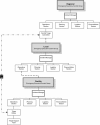Recommendations for intensive care unit and hospital preparations for an influenza epidemic or mass disaster: summary report of the European Society of Intensive Care Medicine's Task Force for intensive care unit triage during an influenza epidemic or mass disaster
- PMID: 20135090
- PMCID: PMC7079971
- DOI: 10.1007/s00134-010-1759-y
Recommendations for intensive care unit and hospital preparations for an influenza epidemic or mass disaster: summary report of the European Society of Intensive Care Medicine's Task Force for intensive care unit triage during an influenza epidemic or mass disaster
Abstract
Purpose: To provide recommendations and standard operating procedures for intensive care units and hospital preparedness for an influenza pandemic.
Methods: Based on a literature review and expert opinion, a Delphi process was used to define the essential topics.
Results: Key recommendations include: Hospitals should increase their ICU beds to the maximal extent by expanding ICU capacity and expanding ICUs into other areas. Hospitals should have appropriate beds and monitors for these expansion areas. Establish a management system with control groups at facility, local, regional and/or national levels to exercise authority over resources. Establish a system of communication, coordination and collaboration between the ICU and key interface departments. A plan to access, coordinate and increase labor resources is required with a central inventory of all clinical and non-clinical staff. Delegate duties not within the usual scope of workers' practice. Ensure that adequate essential medical equipment, pharmaceuticals and supplies are available. Protect patients and staff with infection control practices and supporting occupational health policies. Maintain staff confidence with reassurance plans for legal protection and assistance. Have objective, ethical, transparent triage criteria that are applied equitably and publically disclosed. ICU triage of patients should be based on the likelihood for patients to benefit most or a 'first come, first served' basis. Develop protocols for safe performance of high-risk procedures. Train and educate staff.
Conclusions: Mortality, although inevitable during a severe influenza outbreak or disaster, can be reduced by adequate preparation.
Figures


Similar articles
-
Chapter 2. Surge capacity and infrastructure considerations for mass critical care. Recommendations and standard operating procedures for intensive care unit and hospital preparations for an influenza epidemic or mass disaster.Intensive Care Med. 2010 Apr;36 Suppl 1:S11-20. doi: 10.1007/s00134-010-1761-4. Intensive Care Med. 2010. PMID: 20213417
-
Chapter 7. Critical care triage. Recommendations and standard operating procedures for intensive care unit and hospital preparations for an influenza epidemic or mass disaster.Intensive Care Med. 2010 Apr;36 Suppl 1(Suppl 1):S55-64. doi: 10.1007/s00134-010-1765-0. Intensive Care Med. 2010. PMID: 20213422 Free PMC article.
-
Chapter 3. Coordination and collaboration with interface units. Recommendations and standard operating procedures for intensive care unit and hospital preparations for an influenza epidemic or mass disaster.Intensive Care Med. 2010 Apr;36 Suppl 1(Suppl 1):S21-31. doi: 10.1007/s00134-010-1762-3. Intensive Care Med. 2010. PMID: 20213418 Free PMC article.
-
Surge capacity logistics: care of the critically ill and injured during pandemics and disasters: CHEST consensus statement.Chest. 2014 Oct;146(4 Suppl):e17S-43S. doi: 10.1378/chest.14-0734. Chest. 2014. PMID: 25144407 Review.
-
Civilian triage in the intensive care unit: the ritual of the last bed.Crit Care Med. 1993 Apr;21(4):598-606. doi: 10.1097/00003246-199304000-00022. Crit Care Med. 1993. PMID: 8472581 Review.
Cited by
-
Ten major priorities for intensive care in India.Intensive Care Med. 2015 Aug;41(8):1468-71. doi: 10.1007/s00134-014-3618-8. Epub 2015 Jan 9. Intensive Care Med. 2015. PMID: 25573499 No abstract available.
-
Pandemic response lessons from influenza H1N1 2009 in Asia.Respirology. 2011 Aug;16(6):876-82. doi: 10.1111/j.1440-1843.2011.02003.x. Respirology. 2011. PMID: 21627715 Free PMC article. Review.
-
Airborne Infections and Emergency Surgery: The COVID-19 Pandemic Perspective.J Indian Assoc Pediatr Surg. 2021 Mar-Apr;26(2):76-88. doi: 10.4103/jiaps.JIAPS_99_20. Epub 2021 Mar 4. J Indian Assoc Pediatr Surg. 2021. PMID: 34083889 Free PMC article. Review.
-
Design for Implementation of a System-Level ICU Pandemic Surge Staffing Plan.Crit Care Explor. 2020 Jun 15;2(6):e0136. doi: 10.1097/CCE.0000000000000136. eCollection 2020 Jun. Crit Care Explor. 2020. PMID: 32695999 Free PMC article.
-
A Nursing Care Model for Surge Capacity Management in Intensive Care Units During the COVID-19 Pandemic: Experience From Qatif Central Hospital, Saudi Arabia.Cureus. 2023 Nov 2;15(11):e48193. doi: 10.7759/cureus.48193. eCollection 2023 Nov. Cureus. 2023. PMID: 38050496 Free PMC article.
References
-
- Jain S, Kamimoto L, Bramley AM, Schmitz AM, Benoit SR, Louie J, Sugerman DE, Druckenmiller JK, Ritger KA, Chugh R, Jasuja S, Deutscher M, Chen S, Walker JD, Duchin JS, Lett S, Soliva S, Wells EV, Swerdlow D, Uyeki TM, Fiore AE, Olsen SJ, Fry AM, Bridges CB, Finelli L. The 2009 Pandemic Influenza A (H1N1) Virus Hospitalizations Investigation Team (2009) Hospitalized patients with 2009 H1N1 influenza in the United States, April–June 2009. N Engl J Med. 2009;361:1935–1944. doi: 10.1056/NEJMoa0906695. - DOI - PubMed
-
- Echevarría-Zuno S, Mejía-Aranguré JM, Mar-Obeso AJ, Grajales-Muñiz C, Robles-Pérez E, González-León M, Ortega-Alvarez MC, Gonzalez-Bonilla C, Rascón-Pacheco RA, Borja-Aburto VH (2009) Infection and death from Influenza A H1N1 virus in Mexico: a retrospective analysis. Lancet. doi:10.1016/S0140-6736(09)61638-X - PubMed
-
- Bishop JF, Murnane MP, Owen R (2009) Australia’s Winter with the 2009 Pandemic Influenza A (H1N1) Virus. N Engl J Med. doi:10.1056/NEJMp0910445 - PubMed
-
- Domínguez-Cherit G, Lapinsky SE, Macias AE, Pinto R, Espinosa-Perez L, de la Torre A, Poblano-Morales M, Baltazar-Torres JA, Bautista E, Martinez A, Martinez MA, Rivero E, Valdez R, Ruiz-Palacios G, Hernández M, Stewart TE, Fowler RA (2009) Critically ill patients with 2009 Influenza A (H1N1) in Mexico. JAMA. doi:10.1001/jama.2009.1536 - PubMed
Publication types
MeSH terms
LinkOut - more resources
Full Text Sources
Medical

